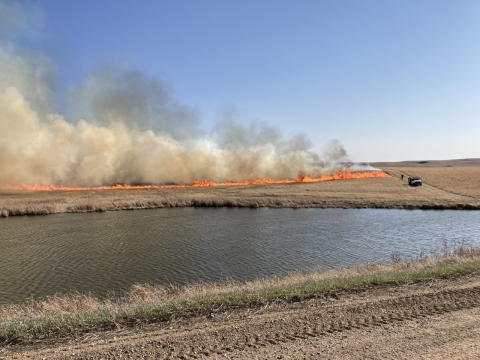What We Do
Wildlife conservation is at the heart of the National Wildlife Refuge System. It drives everything on U.S. Fish and Wildlife Service lands and waters. From the recreational activities offered, to the resource management tools used, refuge system managers use the best conservation practices to ensure the survival of native wildlife species. Lake Ilo National Wildlife Refuge is managed to provide habitat for all wildlife with an emphasis on suitable waterfowl nesting and brood-rearing habitat. Refuge staff use livestock grazing, prescribed burning, invasive species invasive species
An invasive species is any plant or animal that has spread or been introduced into a new area where they are, or could, cause harm to the environment, economy, or human, animal, or plant health. Their unwelcome presence can destroy ecosystems and cost millions of dollars.
Learn more about invasive species removal, mowing, seeding, and manage the water level of the lake to help plants and wildlife. Sometimes, sensitive areas are closed to the public during habitat restoration projects.
Management and Conservation
Refuge staff use a host of scientifically sound management tools to address biological challenges. At this field station, our conservation toolbox includes:
- Planning – Comprehensive Conservation Plan
- Compatibility Determinations
- Cultural Resources
- Education & Outreach
- Fire Management
- Grazing
- Invasive Species
- Inventory and Monitoring
- Law Enforcement
- Pesticide Management
- Recreation Management
- Species Research
- Water Management
Our Services
Lake Ilo National Wildlife Refuge has a park/recreation area on the north shore of Lake Ilo and provides visitors with picnic tables, charcoal grills, litter receptacles, fishing dock, and a restroom. The Refuge is managed by the Audubon Wetland Management District and the Headquarters/Visitor Center Building is located on Audubon National Wildlife Refuge.
Please visit the Audubon National Wildlife Refuge Headquarters and Visitor Center building to learn more about this refuge.
Our Projects and Research
Our National Wildlife Refuges are places for everyone to learn about and discover the outdoors. This opportunity is utilized by numerous local grad students from local universities and other government organizations over the years, researching a wide variety of wildlife and plant species on the refuge. If interested in performing a research project on refuge lands please contact: Audubon National Wildlife Refuge (audubon@fws.gov).
Law Enforcement
U.S. Fish and Wildlife Service law enforcement officers have a wide variety of duties and responsibilities. Officers’ help visitors understand and obey wildlife protection laws. They work closely with state and local government offices to enforce federal, state and refuge hunting regulations that protect migratory birds and other game species from illegal take and preserve legitimate hunting opportunities. Some other duties include patrolling closed areas, maintaining relationships with neighboring landowners, maintaining refuge boundaries and participating in public events related to refuge issues.
Laws and Regulations
The National Wildlife Refuge System, the only system of Federal lands devoted specifically to wildlife, is a network of diverse and strategically located habitats. More than 565 national wildlife refuges and thousands of waterfowl production areas across the United States teem with millions of migratory birds. They serve as havens for hundreds of endangered species and host an enormous variety of other plants and animals. Over 39 million people visit units of the National Wildlife Refuge System each year to enjoy a wide range of wildlife related recreational opportunities. To maintain this system, the passage and creation of laws and regulations, such as the National Wildlife Refuge System Improvement Act, ensures a strong and singular wildlife conservation mission.

